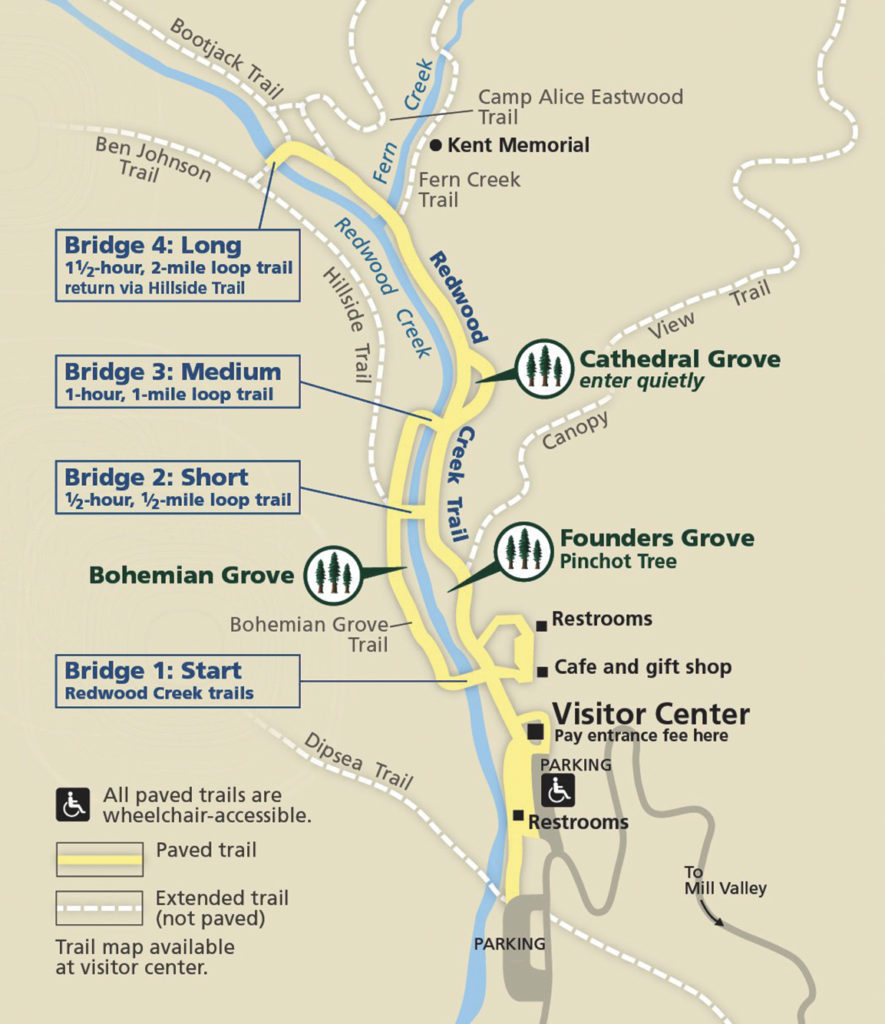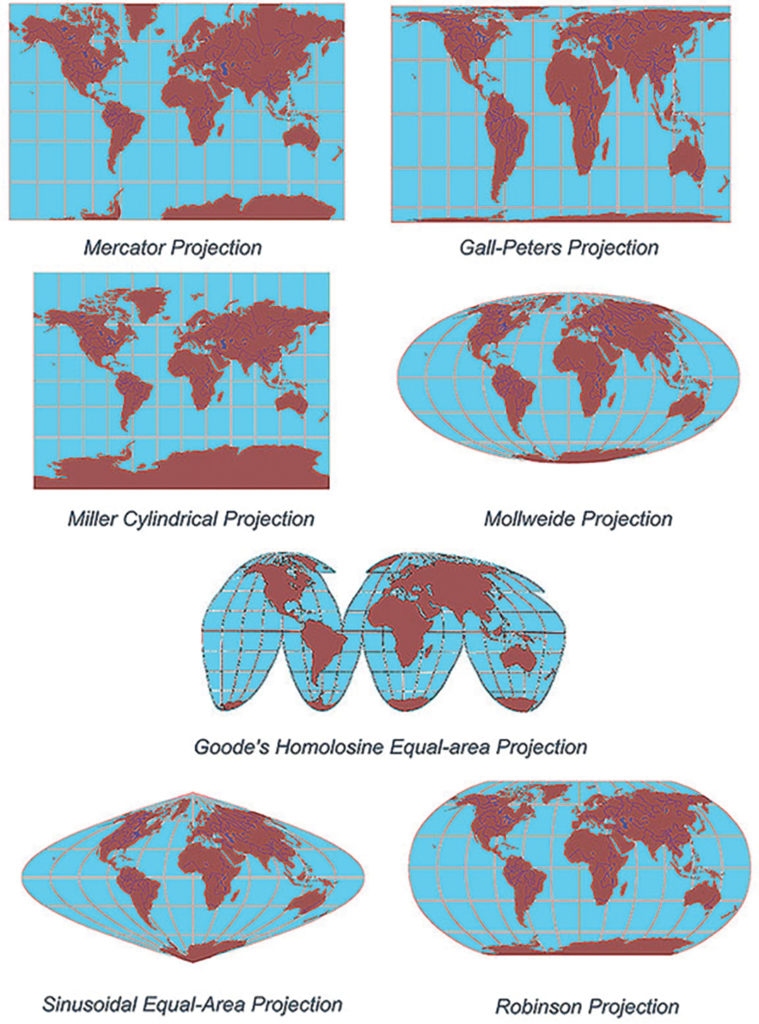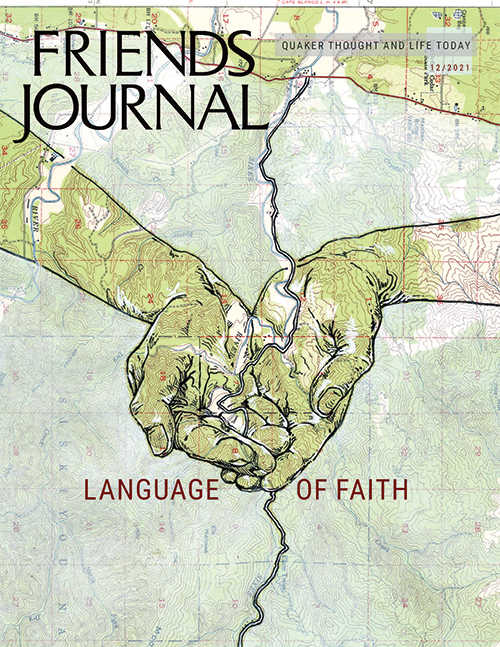Wandering Souls in Search of God
Friends use geographic metaphors all the time: we talk about our spiritual journeys; we talk about the path forward; we talk about way opening.
I started thinking about geographic metaphors more literally a few years ago after visiting Muir Woods National Monument. When you get to the park entrance and have paid your fee, you get a ticket and a brochure filled with beautiful photographs. It has a little blurb about the history of the park, and it has a map. The map shows all the circuit hikes as well as where the bathrooms and the gift shop are. This turned out to be very useful information to which we referred multiple times during our visit. What I realized, though, is that the map missed the single most important thing about Muir Woods. The map in no way helped me understand the experience of standing in a redwood grove.
John Steinbeck, describing redwoods in Travels with Charley, said “From them comes silence and awe.” To me, standing in a redwood forest is the closest thing to a gathered meeting for worship that I have encountered outside of a meetinghouse.
In a redwood forest I feel very close to God. Everything is different. Sunlight filtering through the leaves has a special glow. Sounds have a uniquely subdued quality. There is a particular earthy smell in my nose and taste on my tongue. The air against my skin is cool and somehow a little heavy. A redwood grove engages all my senses and sets my soul soaring. It is truly holy ground. The map captured none of that.
I began thinking I had stumbled across a compelling metaphor: the Muir Woods map contrasted to the reality of the redwood forest as a stand-in for the spiritual guides that I have used over the course of my life contrasted with my reality of experiencing God.
I love maps. My family traveled regularly when I was a child. I cannot remember not knowing how to read a map. I always traced our location: the rivers, the oceans, the cities, the countries. I pored over maps of places I had not yet visited thinking, “How cool would it be to go to Australia or South America?”
There are many spiritual guides that have been important to me, as well: Marcelle Martin and Thomas Kelly; Pendle Hill pamphlets; articles in Friends Journal; workshops and second hours. Many of them have helped me simultaneously expand and focus my spiritual attention. None of them have ever captured the experience of the Divine that I have felt in a meetingroom or in a redwood forest. Spiritual guides and the presence of God are two entirely different things.

U.S. National Park Service map of Muir Woods. Image courtesy of U.S. National Park Service.
The Map Is Not the Territory
Alfred Korzybski coined the statement, “The map is not the territory.” What he meant is that the abstraction of a diagram is different from the landscape that is portrayed.
On the face of it, Korzybski’s adage is not particularly profound. It seems pretty obvious, actually: on the one hand, there is a piece of paper with colored lines and shaded areas, and on the other hand, there are trees and grass and rocks and water. The physical world is only represented by the diagram; they are clearly not the same thing. Reading Thomas Kelly is not the same as experiencing God; that seems equally obvious. And yet, this distinction often seems to get muddled.
One example, at least in my mind, is biblical literalism. Accepting Scripture as the exact, complete, and inerrant Truth is a matter of confusing the map with the territory. Robert Barclay, by contrast, got it right when he wrote that the Bible is “only a declaration of the fountain, and not the fountain itself.”
Canonical declarations of belief—the Apostles’ Creed or the Quaker testimonies (SPICES)—are pretty much by definition elevating an abstraction over direct experience, and thus confusing the map with the territory.
On a more subtle level, I find that every once in a while (when I’m speaking with a friend, or reading, or sitting in worship), all of a sudden, things fall into place. There is an almost audible click, and in an instant, a collection of thoughts or feelings that were previously disjointed become connected. A context or framework appears that pulls everything together. I love that experience. There is a phenomenal energy in that aha! moment.
But I also know that a new framework comes with a cost. What is this new framework missing? What does this new framework prevent me from noticing? So I try to remain aware that my new map is, still, just a map.
Maps Distort
There are different ways of drawing maps, known as “projections.” When I was growing up, the most common world map was the Mercator projection, traditionally with north at the top and Europe in the middle. Over time, other styles have become increasingly common: Robinson projections, Gall-Peters projections, polar projections, etc.
The question naturally arises: Which one of these projections makes the better map of the world? Which one of these projections is more faithful to the earth as it physically exists? The answer is, none of them. It is mathematically impossible to project a sphere onto a plane without distortion. Different projections have different qualities. The Mercator projection does a very good job at positioning a point on the globe in relation to what is north and south of it, but at the expense of misrepresenting the relative size of land masses. The Gall-Peters projection does just the opposite. The Robinson projection comes in somewhere between those two. Cartographers trade off strengths and weaknesses to achieve a balance that, they hope, will best suit their users.
I think that holds true for spiritual guides, as well. Every spiritual guide will inevitably distort the experience of God.
Writers use different approaches to ground their source of spiritual authority and emphasize different aspects of the Divine. These are projections of the authors’ understanding of spiritual Truth. John Wesley, for example, drew on four different sources in coming to theological conclusions: Scripture, tradition, reason, and experience. Liberal Friends tend to emphasize Wesley’s fourth source, experience, though we more often refer to it as “revelation.” I do not believe that any component of the Wesleyan Quadrilateral is sufficient in itself, nor do I believe that even all four together are truly adequate to capture human interaction with the Divine. They are aids for individuals and groups to express a relationship that is inherently nonrational and nonverbal.
A personal example of trying to process different projections of the Divine are the several phases I have gone through when hearing Christ-centered messages in worship. During phase one, words like “sin” or phrases like “inward spiritual participation in Christ’s death and resurrection” would shut me down. I would stop listening. In my more charitable moments, I would think to myself, “This message is not intended for me.” After hearing Friends whom I greatly respect use Christian language often enough, though, it struck me that shutting these messages out was probably not the reaction most conducive to my spiritual growth.
The strategy I came up with in phase two was to take language that was alien to me and translate it into something that felt equivalent and with which I could identify. I employed that strategy for quite a while and learned much from ministry I had previously rejected.
More recently, it occurred to me that my phase two approach was not right either, or not right for me. I started to suspect that my translations were not working properly. When a Friend spoke of “walking with Christ,” she meant something very specific for which there was no equivalent in my vocabulary.
I am now entering phase three, where I am trying hard to understand the original words as spoken. So far, I have not succeeded at this. The phrase “walking with Christ” still does not mean much to me, but I know it means something to Friends for whom I have very high regard. I am not necessarily looking to have the same experience as these Friends, but I am looking to understand their insights in a more genuine way.
Every cartographer knows that making a map without distortions is impossible. Likewise, I suspect most Friends understand that it is impossible to accurately describe the experience of the Divine in words. And yet, cartographers keep making maps, and Friends keep talking about Spirit. I believe it comes down to a fundamental human drive to communicate about the things that are important to us. Even if we know that we can never fully succeed in expressing what it is we are trying to say, we keep trying.

Maps May Contain Errors
Aside from the inevitable distortions, maps may also contain errors. I used to get calls from friends who were coming to visit me. They would say, “Where’s your house? I’m in a dead end and there are no houses here.” It turned out that one popular GPS at that time showed a main thoroughfare running very close to my home. Decades before I moved in, however, the county had closed a section of that road and built a park where it once ran. Apparently, the GPS was based on an obsolete map.
What do we do when there is an error in our map? How do we even know that there is an error? The best way to validate a map may be to go someplace and find out for oneself whether the map does or does not show reality. The second best option may be to trust the reports of someone else who has been there.
Spiritual guides may also contain errors. Leviticus 20:13 (ESV), for example, states: “If a man lies with a male as with a woman, both of them have committed an abomination; they shall surely be put to death; their blood is upon them.” How do I know this is an error? Because I know many LGBTQ+ persons who are both spiritual and ethical exemplars for me. But there remain many people in the world today, many of them powerful, who take Leviticus literally and seriously. They are following an inaccurate map that has caused, and continues to cause, terrible suffering to millions and millions of human beings.
To take another example, in the Sermon on the Mount, Jesus comes out very strongly against divorce. Though I would never recommend divorce as something to which anyone should aspire, I believe that this portion of his sermon is wrong. Based on my own experience and the experience of others whom I trust, I believe there is an error in that part of Jesus’s map.
Friends rely on revelation, that of God speaking to each of us, and on clearness processes within the community. We rely on continuing revelation in which dimensions of Truth are unveiled over time—or at least our understanding of them unfolds over time. Continuing revelation is the method that Friends use to avoid being stuck with incorrect maps.
I think that seeking a destination without having a map is a very good metaphor for meeting for worship. Waiting expectantly in silence is navigating without a map. We know what we seek but do not know how to get there. Our minds become still and our souls wander, trying to find God.
Navigating without a Map
The last train of thought I would like to pursue is what we do when we are trying to find a location, but we do not have a map. This scenario is much less common than it used to be, but sometimes I leave my phone at home, or I cannot get a signal, or my battery is dead.
There are two basic strategies to find your way to an unfamiliar location when you do not have a map.
The first strategy is what I call the introvert’s approach. I drive or walk around, desperately hoping to come across something that looks familiar: a sign, or maybe a landmark off in the distance, anything that will help me get closer to my destination. This is not an efficient strategy (though I am surprised by how often it works for me).
The introvert’s approach does have some interesting side benefits. I get to know a particular neighborhood much better than I would have otherwise, since I am paying close attention. If I ever end up in that neighborhood again, I will recognize it.
The second benefit of this process is finding things that I never would have encountered had I not been lost. I have found churches, museums, markets, and open-air concerts, some of which turned out to be considerably more exciting than the thing I was looking for in the first place.
The extrovert’s approach, by contrast, is to stop and ask a passer-by for directions. It is an effective strategy for finding where you are going and has the side benefits of encountering people whom one would not otherwise have met, and often learning things that have nothing to do with one’s destination but are interesting in their own right.
I think that seeking a destination without having a map is a very good metaphor for meeting for worship. Waiting expectantly in silence is navigating without a map. We know what we seek but do not know how to get there. Our minds become still and our souls wander, trying to find God. We become familiar with spiritual neighborhoods that engage us. Often we stumble upon insights that we were not looking for but which turn out to have critical importance for us.
Vocal ministry during worship is Friends giving us directions: “Turn right on compassion, then down three blocks to forgiveness.” Friends share the words that God has given them to help us find a holy center.
What early Friends gave us was a journey; they did not give us maps. And I believe that what they gave was truly inspired, and that has made all the difference. I believe that the experience of seeking the Divine without maps is exactly what makes it possible for us to find God.






What a great article! thank you Michael for sharing this, it has given me, not really a map, but lots of insights and inspiration.
Thank you for this wonderful article! I have recently become interested in maps-of real and imagined places, so this was particularly timely for me. Beautifully written to engage the reader in each of the approaches, with and without maps. I only wish I had seen the Redwoods.
Thank you, Friend Michael D. Levi! This is a profoundly wonderful exploration of spirit and discovery.
Hello, Michael: Thanks for your honest attempt to navigate the Quaker terrain without a map. With considerable regret, I feel led to rain on your parade! I have been a Friend since I was 18 years old; “been there, done that,” as some would say. My sense is that many Friends have thrown away the most important Christian maps we have access to, particularly the Bible. They have also abandoned the Quaker maps that Friends in the past used, in the form of spiritual autobiographies called “journals”. Take a look at the meetinghouses in southeastern Pennsylvania; what you see is what you get when you dispense with spiritual maps. What I see is many empty meetinghouses! And, where there are still Friends in some places, many of them (as someone said to me about New York Yearly Meeting) are “old grey heads.” We dare not abandon all of our maps! I wish you the best, and hope that we someday meet along the way.
“Truth Is a Pathless Land”–Krishnamurti